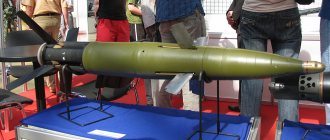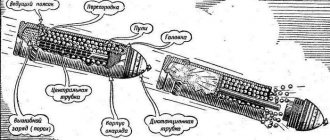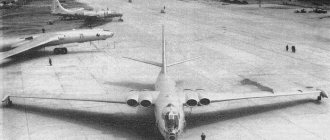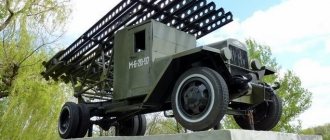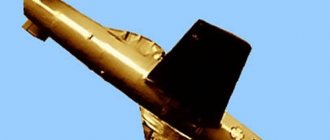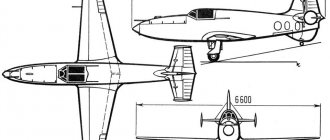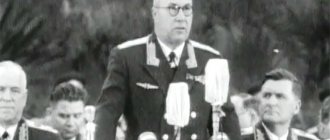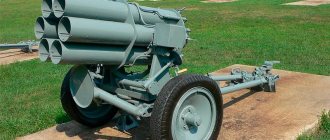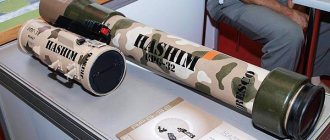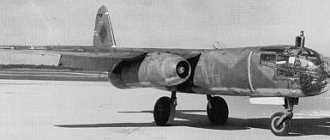Howitzer M-30 model 1938 122-mm performance characteristics. Firing range. Dimensions. Weight
A battery of Soviet 122-mm M-30 howitzers, model 1938, fires at Berlin.
The 122mm M-30 howitzer, also known in the West as the M1938, is a stalwart veteran. It was developed back in 1938, and its industrial production began the following year. Produced in thousands and widely used in combat during the Great Patriotic War. The M-30, virtually unchanged, is still widely used in the CIS countries and many other countries, although at present in many armies it is used only for training purposes or transferred to reserve.
Howitzer M-30 - video
Although production of the M-30 in the CIS countries ceased several years ago, the howitzer is still produced in China under the designation 122 mm howitzer Type 54 or Type 54-1 - the latter modification has several design differences due to the peculiarities of local technology.
In general, the 122-mm M-30 howitzer has a classic design: a durable, reliable two-frame carriage, a rigidly mounted shield with a liftable central plate, and a 23-caliber barrel without a muzzle brake. The gun is equipped with the same carriage as the 152 mm D-1 (M1943) howitzer. Large-diameter wheels are equipped with solid slopes filled with sponge rubber, but the M-30 modification, produced in Bulgaria, has wheels of a different design. Each implement has two different types of openers - for soft and hard soil.
At one time, the M-30 howitzer was the main armament of the SU-122 self-propelled artillery mount, created on the chassis of the T-34 tank, but at present there are no such installations left in any army. The following self-propelled artillery mount is still produced in China: the Type 54-1 howitzer is mounted on the chassis of a Type 531 armored personnel carrier.
The main type of ammunition for M-30 howitzers is a highly effective fragmentation projectile weighing 21.76 kg. having a range of up to 11,800 meters. To combat armored targets, the BP-463 armor-piercing cumulative projectile can theoretically be used, capable of penetrating armor up to 200 mm thick at a maximum direct shot distance of 630 meters, but currently such ammunition is practically not used.
A battery of Soviet 122-mm howitzers M-30 on the streets of Berlin.
Modifications and prototypes based on the M-30
During production, the design of the gun as a whole did not change significantly. The following types of artillery pieces were produced on the basis of the M-30 howitzer barrel group:
M-30S (GAU index - 53-GS-463) - a slightly modified version of the M-30 for installation on the SU-122 self-propelled artillery mount.
The U-11 is a new weapon with ballistics identical to the M-30, designed to arm tanks and self-propelled guns. The U-11 gun differed from the M-30 in the greatly modified design of the recoil devices, which were reduced in size for a better layout in the cramped conditions of the vehicle's fighting compartment. The self-propelled version of the U-11 was installed on the experimental self-propelled gun SU-122M, but did not pass tests due to low reliability. Tank version of the howitzer
The U-11 was installed on the experimental tank Object 234 , which is also known as IS No. 2 (not to be confused with the production IS-2, armed with a long-barreled 122 mm D-25 cannon).
D-6 is another variant of a howitzer with ballistics identical to the M-30, intended for installation in self-propelled guns. The D-6 howitzer was mounted on an experimental self-propelled gun SU-122-III, but, like the U-11, it did not pass the tests due to low reliability.
Self-propelled artillery units with M-30
Self-propelled gun SU-122
The M-30 was installed on the following self-propelled guns:
SU-122 . Self-propelled guns based on the T-34 tank. Produced from December 1942 to August 1943. A total of 638 units were produced.
SG-122 . Self-propelled guns based on captured German tanks PzKpfw III and StuG III self-propelled guns. About 20 pieces were produced. early 1943
12.2-cm Kanone (r) auf Geschützwagen Lorraine-Schlepper (f). A German self-propelled gun, which is an installation of a captured M-30 howitzer on the chassis of a captured French Lorraine tractor. One example of this self-propelled gun is known to have operated in France on a railway platform that was part of an armored train.
Crew of the Soviet 122-mm howitzer M-30 in battle against German tanks. In the foreground is a dead artilleryman. 3rd Belorussian Front.
M-30 family rocket launchers
During the Great Patriotic War, Soviet designers actively worked to improve the performance of various military equipment, including rocket launchers. Due to the introduction of new ideas, it was possible to significantly increase certain indicators. In addition, the problems of using available chassis and ammunition were solved. At the beginning of 1942, work began to increase the firepower of rocket launchers. The work, which began with the creation of a new missile, led to the appearance of several original launchers. M-30 rocket
The BM-13 Katyusha rocket launchers showed high combat effectiveness already in the first months of the war. Each such vehicle sent 16 missiles with 4.9 kg of explosives each to the enemy in a few seconds. The impact of a battery of such combat vehicles hit enemy personnel, equipment and buildings over large areas. Despite their fairly high efficiency, BM-13 mortars with M-13 shells had disadvantages. In some cases, the performance of a combat mission was complicated by the insufficient power of the projectile warhead used. Despite the massive attacks, some enemy fortifications could remain intact after the salvo.
The development of the new missile was undertaken by specialists from the Main Armament Directorate. Already in May 1942 they finished work on the M-30 product. Due to limited industrial capabilities and the need to start production as soon as possible, it was decided to make the M-30 missile based on the existing M-13. The engine, tail section of the hull and stabilizer design were borrowed from the latter. These units were supplemented by a new ellipsoidal warhead with a maximum diameter of 300 mm, which allows the M-30 projectile to be classified as over-caliber.
Despite the use of a new warhead, the M-30 projectile turned out to be slightly shorter than the base M-13. Its length without a fuse was 1.4 m. The tail part of the body had a diameter of 132 mm, the head – up to 300 mm. Due to different design characteristics, it was necessary to use a stabilizer with eight planes. To avoid deformation during transportation and launch, they were connected using a special ring. The general layout of the M-30 and M-13 products was the same.
The M-30 missile, ready for launch, weighed 72 kg. The new warhead managed to fit 28.9 kg of explosive. Thus, the power of the new rocket should have been significantly superior to all existing ones.
In the rear part of the M-30 projectile body there was a solid propellant engine, borrowed unchanged from the M-13 rocket. A charge weighing 7.1 kg ensured delivery of the warhead to the target, although due to its greater mass the new projectile was seriously inferior in its characteristics to the existing M-13. A 72-kilogram product could accelerate only to 190-195 m/s, and the maximum table firing range was 2800 m.
In mid-1942, Soviet enterprises mastered the production of three variants of the M-30 projectile. Due to various design features, it was proposed to change the characteristics of the weapon. In addition, two types of warhead were proposed.
The main variants of the M-30 projectile were modifications known under the ballistic indices TS-16 and TS-20. The first had a blunt head fairing, the second was equipped with a sharp one. The TS-16 product could hit targets at ranges from 1600 to 2500 m. The sharp fairing increased the flight range to 1800-2800 m. There was also a TS-20 incendiary projectile with a range from 1800 to 3500 m.
M-30 launcher
According to calculations, M-30 shells could significantly increase the firing efficiency of rocket launchers. However, when searching for a suitable launcher, the project’s authors encountered certain difficulties. None of the combat vehicles that existed at that time could use the over-caliber M-30. It was necessary to develop special devices adapted to work with new missiles.
In May 1942, Moscow, already involved in the creation of rocket mortars, received an order to develop and build a launcher for M-30 shells. By analogy with the projectile, the promising device was designated M-30. The project manager was V.A. Rudnitsky.
Wanting to simplify the design and, as a result, the production of new weapons, Kompressor employees proposed using the enemy’s ideas. At this time, the Wehrmacht was armed with Schweres Wurfgerat (“Heavy Throwing Device”) launchers, designed to launch rocket mines of 280 and 320 mm caliber. This device had an extremely simple design and was a lightweight machine made of wood or metal. A box-cap with a rocket was installed on the mounts of this machine. During launch, the box served as a guide.
Soviet engineers decided to develop the German idea and create a launcher with a large number of guides. The M-30 product had an extremely simple design. It was a lightweight frame made of metal housings, equipped with racks for installation at the desired elevation angle. There were relatively simple vertical guidance systems. The design of the launcher also included openers, with the help of which it was held in place during firing.
The main frame of the M-30 launcher was about 150 cm wide, which made it possible to attach four closures with rockets to it. Wooden boxes were attached to the frame using metal ties. Also included in the package was a set of electrical equipment. To launch electrically ignited projectiles, a sapper blasting machine and a set of cables were used. If there was a need to control several installations by one operator, it was intended to use “Crab” type electrical distribution devices.
M-30 missiles were supplied in special closures called "Box 30".
The closure was made from several wooden blocks and metal strips. The main element of “Box 30” were four one and a half meter beams, which were connected using several relatively short strips. As a result of assembly, the wooden parts formed a rectangular structure, inside which a rocket was placed. The ends of the closure were closed with removable lids. Since the rocket was supposed to launch directly from the box, the inner surface of its longitudinal elements was lined with metal strips. During launch, the head of the projectile and the tail stabilizer ring had to slide along them. M-30 in battle On
July 5, 1942, the 68th and 69th Guards Mortar Regiments used M-30 rockets with launchers of the same name for the first time in combat. The first strike using these weapons was delivered against enemy fortifications in the area of Belyov (Tula Region). Quite quickly, the new weapon demonstrated all its positive and negative qualities.
The main advantage of the M-30 ammunition was the high explosive weight of the warhead. 28.9 kg of explosives was enough to destroy manpower and various equipment. In addition, a massive strike using a large number of similar shells could destroy various fortifications. It is known that a heavy projectile could pierce a brick wall up to 75 cm thick. When the fuse was set to detonate with deceleration and hit medium-hard soil, a crater with a diameter of up to 8 and a depth of up to 2.5 meters was formed.
However, the new weapon also had noticeable disadvantages. Due to the large mass, a projectile with an M-13 engine could fly to a distance of no more than 2800 m. Due to various factors influencing the deviation from a given trajectory, the actual firing range with a maximum elevation angle could be less. In addition, the M-30 missile was not highly accurate. The thickened head part, despite its streamlined shape, spoiled the aerodynamic characteristics of the projectile. The use of closure boxes with relatively short guides also affected the accuracy. As a result, the M-30 was 2.5 times inferior in accuracy to the base M-13.
Low accuracy had to be compensated by the number of missiles launched. In preparation for striking enemy positions, it was recommended to deploy at least three divisions (144 launchers) per kilometer of front. In this case, the total salvo would bring down 576 missiles with 28.9 kg of explosives each on the enemy. With such intensity of fire, the required impact on the enemy was achieved.
In preparation for firing, the crew of the M-30 rocket mortar had to correctly carry out all the necessary procedures, as well as take care of their safety. All mortar units were transported by trucks. Upon arrival at the scene, the crew unloaded all components of the weapon and began preparing for shooting. The launcher was installed on the prepared site. At this stage, the direction of fire was set, since the M-30 installation was not equipped with horizontal guidance mechanisms.
Four “Box 30” with rockets were placed on the mounted launcher. The boxes were secured to the supporting frame with a set of special ties. Despite its apparent simplicity, securing the boxes was one of the most critical stages in preparing the mortar. There are known cases when, due to improper assembly of the closure and insufficiently strong fastening, the missile flew away along with the box. All this seriously complicated the calculation work. Finally, due to the short flight range of the missiles, the crew risked being detected by the enemy during deployment, with subsequent tragic consequences.
It is necessary to note another aspect of the operation of M-30 systems, which is not directly related to the characteristics. The BM-13 rocket launcher quickly received the name “Katyusha”. Heavy rockets, starting with the M-30, also did not remain without nicknames. By analogy with the “Katyushas” they were called “Andryushas”. In addition, due to the characteristic shape of the rocket's head, they received the nickname "Luka" in honor of the title character of an old pornographic poem. For obvious reasons, the harmless nickname “Andryusha” is more common in official sources and historical studies. Subsequently, both nicknames were transferred to another technique that used over-caliber rockets.
Some sources mention a front-line legend about the combat equipment of M-30 shells and other similar heavy weapons. There were rumors among the Red Army soldiers about the use of some special high-power explosive. The destruction left after the impact fueled the spread of this version. However, the ellipsoidal head of the projectiles contained standard explosives used in the manufacture of all Soviet artillery ammunition. The causes of significant destruction, in turn, were the large weight of the charge and the massive use of such weapons.
M-31 rocket
The balance between the pros and cons of the M-30 projectile led to demands for the development of a new ammunition with similar combat qualities, but an increased firing range. At the very end of 1942, the development of a new missile called M-31 (ballistic index TS-31) was completed. While maintaining the general architecture of the product, its developers managed to significantly change the flight data, primarily speed and range.
The M-31 projectile received a new tail section with an updated solid propellant engine. The total length of the projectile without a fuse was 1760 mm, the over-caliber warhead had a maximum diameter of 300 mm. An interesting feature of the M-31 product was the design of the warhead. By reducing the thickness of the ellipsoid walls from 7 to 4 mm, it was possible to reduce the weight of the head housing by almost 13 kg and bring it to 10.8 kg. The charge remained the same - 28.9 kg. The starting weight of the projectile was 92.4 kg.
Several engine powder bombs with a total mass of 11.2 kg were placed in the rear part of the hull, which led to an increase in thrust and, as a consequence, flight data. The maximum speed of the M-31 rocket reached 250-255 m/s. Thus, despite the increase in the total weight of the projectile, the new engine made it possible to improve performance in comparison with the existing M-30. The maximum table range was 4325 m.
The M-31 projectile was put into service in January 1943 and soon began to enter the army. The development of the rocket did not stop there. In the spring of 1944, the M-31-UK projectile (“improved accuracy”) was put into service. The only difference between this product was the four L-shaped tubes on the body of the solid propellant engine. Some of the powder gases were released through these tubes and forced the rocket to rotate around its longitudinal axis. Such modifications made it possible to almost double the accuracy of fire, but led to a decrease in the maximum range to 4 km.
Production of the M-31 rockets began in the last weeks of 1942. Soon this weapon showed its advantages over the existing M-30. The result of this was the decision to cease production of obsolete M-30 missiles. The last batch of such shells was handed over to the troops in February 1943.
M-30 launcher with M-31 shells
It was proposed to use M-31 missiles with existing M-30 launchers. These devices were simple in design and quite easy to use. Increasing the firing range was supposed to have a positive effect on the characteristics of the entire system, including the likelihood of detection of the rocket mortar by the enemy.
Four wooden caps with rockets were placed on the frame of the M-30 installation. The design of the boxes made it possible to launch projectiles without the use of separate guides.
In the spring of 1943, the industry began producing a new version of the M-30 launcher with a reinforced frame and modified mounts for boxes with missiles. Due to all the changes, it was possible to increase the salvo to eight shells. In this case, the boxes were stacked in two rows of four each. It should be noted that a fundamentally new launcher was not created in 1943. Similar improvements to the M-30 system were previously carried out in military workshops as a “bottom-up initiative.” , in turn, only improved the idea of the gunners and made it an official modification.
The introduction of the updated M-30 launcher into service had the most positive impact on the firepower of the Guards mortar regiments and divisions. An excellent example of the effectiveness of such weapons is the results of the attack carried out by the 7th Guards Mortar Division in early August 1943. At the beginning of the Smolensk offensive operation (Operation Suvorov), the division carried out two full-scale salvoes from the available 432 M-30 rocket mortars. Each divisional salvo consisted of 3,456 shells. Almost 100 tons of explosives fell on the enemy twice. Later it became known that the 7th Guards Mortar Division destroyed 550 linear meters of trenches and trenches, 114 dugouts, 27 firing points, 43 artillery pieces and 23 mortars.
M-31 launcher
Until October 1943, M-30 and M-31 shells were launched using the M-30 installation. In the fall of 1943, the creation of a new M-31 launcher was completed. It was a modified version of the basic M-30 using new materials and parts. In addition, the design used some innovations related to the dimensions and weight of the M-31 projectiles. Like the existing launcher, the new M-31 had mounts for eight cappings with rockets.
Soon a new version of the M-31 launcher appeared. Its tests took place at the very beginning of 1944, after which this system was put into service. M-31 launchers have been actively used for quite a long time. The outdated M-30 systems were gradually replaced by the new M-31.
The M-30 and M-31 launchers were supposed to fire from the ground. To increase mobility, a towed version of the M-31 system on wheels was proposed. In this case, the launcher with horizontal and vertical guidance mechanisms was mounted on a two-wheeled trolley with jacks in the front and two frames in the rear. In its general architecture, this version of the M-31 installation resembled the carriages of various artillery pieces. Before the end of 1943, a prototype of a towed wheeled rocket mortar was manufactured and tested. Despite the obvious advantages, this system was not adopted for service.
In May 1944, operation of a lightweight launcher based on the M-31 began. It differed from the basic version in the number of fastenings for boxes with missiles. It was allowed to install six closures in two rows. This launcher was actively used in parallel with other devices for 300-mm super-caliber rockets.
Increased mobility
The M-30 and M-31 rocket launchers had a serious drawback: low mobility. Launcher units and shells were transported on trucks, and deployment to a position took up to several hours. For these reasons, preparing to fire was difficult and dangerous. At the very beginning of 1943, work began on creating a self-propelled version of the launcher for M-30 and M-31 projectiles.
The first versions of such projects involved installing a modified launcher of an existing design on a suitable vehicle. A few months after the start of work, an experimental combat vehicle based on the ZIS-6 truck with a modified M-30 launcher appeared. As before, it was proposed to launch projectiles from wooden caps.
In the first months of 1944, Kompressor employees assembled a similar combat vehicle based on the Studebaker US6 chassis. This car has been tested and given good ratings. According to some reports, a prototype M-30 on an American-made chassis a little later reached the front, where it underwent military tests in real combat conditions.
Installing starting devices on a car chassis solved the problem of mobility. However, the accuracy and accuracy of fire left much to be desired, which required further development of this technique. Solving this problem, gunsmiths began to use proven solutions. In mid-1944, an experimental BM-31-12 rocket mortar with full-fledged tubular guides entered testing. Soon such equipment began to enter the army, and over time, due to the realization of its advantages, it almost completely replaced the outdated M-30 and M-31 launchers.
Based on materials: https://rbase.new-factoria.ru/ https://military1941.ru/ https://callig-museum.ru/ https://za-cccp.narod.ru/ https://tehnikapobedy .ru/ https://epizodsspace.no-ip.org/ Shirokorad A.B. Domestic mortars and rocket artillery. – Mn.: Harvest, M.: “AST Publishing House” 2000
M-30 howitzer ammunition
The M-30 fired a full range of 122mm howitzer shells, including a variety of old Russian and imported grenades. After the Great Patriotic War, new types of ammunition were added to the range of projectiles listed below, for example, the 3BP1 cumulative projectile.
The 53-OF-462 steel high-explosive fragmentation grenade, when the fuse was set to fragmentation action, when it exploded, created about 1000 lethal fragments, the effective radius of destruction of manpower was about 30 m (data obtained using the Soviet measurement method of the mid-20th century). When the fuse was set to the high-explosive action of the grenade, after the explosion it left craters up to 1 m deep and up to 3 m in diameter. In the early 1970s, new 3OF24 ammunition entered service with the 122-mm howitzers 2S1, D-30 and M-30. Instead of TNT, composition A-IX-2 was used as an explosive, due to which the effectiveness of 3OF24 projectiles was increased by 1.2-1.7 times compared to 53-OF-462. Since 1982, the 3OF56 and 3OF56-1 projectiles of increased power have entered service with 122-mm howitzer systems.
The 53-BP-460A cumulative projectile penetrated armor up to 100-160 mm thick at an angle of 90° (different sources provide different data). The target firing range for a moving tank is up to 400 m. The post-war 3BP1 cumulative projectile penetrated at an angle of 90° - 200 mm, 60° - 160 mm, 30° - 80 mm.
The crew of a 122-mm M-30 howitzer fires at the enemy on one of the streets of Vienna.
Combat use
The M-30 was used for firing from closed positions at entrenched and openly located enemy personnel. It was also successfully used to destroy enemy field fortifications (trenches, dugouts, bunkers) and to make passages in wire fences when it was impossible to use mortars. The defensive fire of the M-30 battery with high-explosive fragmentation shells posed a certain threat to enemy armored vehicles. The fragments formed during the explosion were capable of penetrating armor up to 20 mm thick, which was quite enough to destroy armored personnel carriers and the sides of light tanks. For vehicles with thicker armor, shrapnel could damage chassis components, guns, and sights.
To destroy enemy tanks and self-propelled guns in self-defense, a cumulative projectile, introduced in 1943, was used. In his absence, the artillerymen were ordered to fire high-explosive fragmentation shells at the tanks with the fuse set to high-explosive action. For light and medium tanks, a direct hit from a 122-mm high-explosive shell was fatal in many cases, even leading to the turret being torn off its shoulder strap. Heavy "Tigers" were a much more stable target, but in 1943 the Germans recorded a case of causing heavy damage to tanks of the PzKpfw VI Ausf H "Tiger" type during a combat clash with Soviet SU-122 self-propelled guns armed with M-30 howitzers.
Crew of the Soviet 122-mm howitzer M-30 at a position on the Frische Nehrung Spit (now the Baltic Spit). 11th Guards Army.
Guards rocket mortar
On June 26, 1941, at plant No. 723 of the People's Commissariat of Mortar Armaments of the USSR in Voronezh, the assembly of the first two serial BM-13 launchers on the ZIS-6 chassis was completed, and they were immediately accepted by representatives of the Main Artillery Directorate. The next day, the installations were sent under their own power to Moscow, where on June 28, after successful tests, they were combined with five installations previously manufactured at the RNII into a battery for sending to the front.
The production of BM-13 units was organized at the Voronezh plant named after. Comintern and in Moscow (chief designer - V.P. Barmin). One of the main enterprises for the production of rockets was the Moscow plant named after. Vladimir Ilyich. The last 2 plants were evacuated to Chelyabinsk in 1941[7].
BM-31-12 on the ZIS-12 chassis in the Museum on Sapun Mountain, Sevastopol BM-13-16 on the basis of STZ-5-NATI
During the war, various versions of the rocket and launchers were created: BM-13-SN (with spiral guides, which significantly increased the accuracy of fire), BM-8-48, BM-8-24, BM-13N and others. In 1942, M-31 shells of 310 mm caliber appeared, which were initially launched from ground-based installations. In April 1944, a self-propelled unit with 12 guides was created for them, mounted on a truck chassis. It was named "BM-31-12".
There were launchers based on machine guns (M-8-6, M-8 projectile, 6 guides), snowmobiles, motorcycles (BM-8-12, M-8 projectile, 12 guides), and, as mentioned above, - just ground frames (M-30-4, M-30 and M-31 shells, 4 guides).
Also, the frames were installed on railway platforms (BM-8-72, BM-13-16, BM-8-48). The BM-8-24 installation, created in 1941, had an artillery unit equipped with aiming mechanisms and sighting devices with guides for launching 24 M-8 rockets. The artillery unit was mounted on the roof of a T-40 tank instead of a turret. When the T-40 tank was discontinued, the T-60 began to be used as a base for the BM-8-24. BM-8-24 was used at the initial stage of the war. After the end of production of the T-60, production of the BM-8-24 was also curtailed, but its modified artillery unit was used for the BM-8-48 installations, which were installed on the domestic GAZ-AA truck and on Lend-Lease Studebaker and Ford Marmont -Harrington"[8].
The STZ-5-NATI tracked tractors, Ford Marmont, International, GMC, Austin and others all-terrain vehicles obtained under Lend-Lease were also equipped with rocket launchers. In 1942, work was carried out on the KARS-1 launcher for M-13 missiles on the KV-1 tank chassis, but these ideas were not developed due to the cessation of production of KV tanks.
In the summer of 1942, when fighting began in the Caucasus, a need arose for light mountain-pack launchers. In makeshift conditions in Sochi, the “younger sister of Katyusha” M-8-8 was created. 8 rockets were fired almost simultaneously. Weight - 68 kilograms. The M-8 performed well in mountain conditions. The M-8 was also installed on torpedo boats - subsequently used in Malaya Zemlya, Crimea, the Carpathians, battles in Mongolia and China, and then in North Korea.
During the war, the production of launchers was urgently launched at several enterprises with different production capabilities, and in connection with this, more or less significant changes were made to the design of the installation. Thus, the troops used up to ten varieties of the BM-13 launcher, which made it difficult to train personnel.
An improved modification of the BM-13N (N - “normalized”) was created in 1943; until the end of the war, about 1,800 such units were manufactured. BM-13N were produced on the basis of the well-proven American Studebaker US6 trucks, supplied to the USSR under Lend-Lease.
Soviet industry in July 1941 - December 1944 produced about 11 thousand Katyusha launchers for combat vehicles and over 12 million rockets for them (all calibers). The first vehicles were manufactured on the basis of domestic chassis (about 600 in total - most were destroyed in battle. On October 11, 1941, 7 Katyusha units with shells were captured by Nazi troops in the battles for Mtsensk[9]), after the start of Lend-Lease During the period of supply, the main chassis for the BM-13 (BM-13N) was the American Studebaker (about 200 thousand cars were supplied from America).
Statistics on types of multiple launch rocket systems: during the Second World War, about 11 thousand Katyusha launchers were produced for 3374 chassis of combat vehicles (372 based on ZiS-6, 1845 - Studebakers, 1157 - other 17 types of chassis).
- BM-8 - 2400 entered service, 1400 were lost;
- BM-13 - 6800 received, 3400 lost;
- BM-31 - 1800 received, 100 lost.
Tactical and technical characteristics of the M-30 howitzer
— Produced, pieces: 19,266
Calculation: 8 people
Rate of fire M-30
— 5-6 rounds/min
— Initial projectile speed: 515 m/s — Vehicle speed on the highway, km/h: up to 50 — Height of the firing line, mm: 1200
Firing range of the M-30
— Maximum firing range: 11,800 m
Overall dimensions M-30
— Length, mm: 5900 (with front end 8600) — Width, mm: 1975 — Height, mm: 1820 — Ground clearance, mm: 330—357 — Barrel length, mm/club: 2800/22.7 — Barrel bore length, mm /klb: 2278/18.7 (rifled part)
Weight M-30
— Weight in stowed position, kg: 2900—3100 — Weight in combat position, kg: 2360—2500
— Firing angles — BH angle, degrees: from −3 to +63.3° — GN angle, degrees: 49°
300-mm high-explosive rocket projectile M-31
Designed to destroy fortified points and enemy resistance centers, engineering structures and obstacles. The M-31 projectile consisted of two main parts: the head and the rocket.
The head part consisted of the head body and explosive charge 9, ammatol or TNT.
The head body consisted of two welded ogival halves. In the frontal part of the head housing there was a hole through which the explosive charge was fired. After arming, bushing 1 with a point for the GVMZ fuse was screwed into this hole. At the rear of the head housing there was a welded bottom with a thread for screwing into the rocket chamber.
The rocket part consisted of a rocket chamber block with a nozzle 11 and a stabilizer 12.
A charge of nitroglycerin powder was placed in the rocket chamber, consisting of five single-channel cylindrical blocks 3, which are separated from the nozzle part by a grate 8. The outer diameter of the block is 46 mm, the channel diameter is 8 mm, the length of the block is 900 mm.
To ignite the powder charge, an igniter 5 made of black gunpowder weighing 75 g was located in the rocket chamber. The igniter was inserted into a plywood diaphragm. The igniter was ignited by an electric igniter sewn into the igniter cartridge. Wires 6 from the electric fuse ran along the entire length of the rocket chamber; their ends were placed in the exit cone of the nozzle between two cardboard plates.
To give the M-31 projectile stability in flight, there was a stabilizer consisting of a fairing, eight wings and a guide ring 7. The ring served to guide the tail of the projectile as it moved along the guide cells.
Also see the diagram of the M-31 projectile from the Service Manual for the BM-31-12 combat vehicle, released in 1955 ().
Based on the M-31, the M-31-UK projectile was developed.
| Caliber, mm | 300 | |
| Stabilizer wingspan, mm | 300 | |
| Total length of the projectile (without fuse), mm | 1760 | |
| Weight of the finally equipped projectile, kg | 94,8 | |
| Head type | high explosive | |
| Weight of the equipped head part, kg | 52,4 | |
| Bursting charge weight, kg | 28,9 | |
| Missile part weight, kg | 42 | |
| Powder charge weight, kg | 11,25 | |
| Fuse | GVMZ | |
| Resistance of the incandescent bridge of the electric igniter, Ohm | 1,0-1,4 | |
| Current required to ignite the electric igniter, A | not less than 0.5 | |
| Balistic data | ||
| Rocket charge burning time, s | 0,9 | |
| Average reaction force, kg | 2500 | |
| Muzzle velocity of the projectile, m/s | 35 | |
| Length of the active trajectory section, m | 115 | |
| Maximum projectile speed, m/s | 245 | |
| Maximum firing range, m | 4000 | |
Photo of the M-30 howitzer
A battery of Soviet 122-mm howitzers, model 1938, M-30, at a firing position in the Berlin area.
A Soviet tractor transports a 122 mm M-30 howitzer along Frunze Street in liberated Vitebsk.
A battery of Soviet 122-mm M-30 howitzers fires at the enemy in Budapest.
The STZ-5-NATI tractor of the 3rd Guards Artillery Division tows a 122-mm M-30 howitzer across a crossing in the Smolensk region.
A Soviet artillery crew is busy equipping a trench and preparing a 122-mm M-30 howitzer of the 1938 model for firing.
A battery of Soviet 122 mm M-30 howitzers near Moscow is firing. They stand tightly and without any camouflage. The likely absence of an immediate threat from enemy weapons (considerable distance from the front line and, probably, bad weather) makes it possible to do without dispersing and camouflaging firing positions, thereby reducing the time to prepare guns for opening fire and facilitating battery fire control.
The gun crew of the 1st battery of the 208th howitzer artillery regiment fires at the enemy from a 122-mm M-30 howitzer.
Soldiers of the US 84th Infantry Division inspect a Soviet-made 122mm M-30 howitzer abandoned by the Germans in Bensheim. According to the German classification, the captured howitzer was designated sFH396(r).
Gun (122-mm M-30 howitzer) of Sergeant Major I.D. Shcherbakova fires at German strongholds. 1st Belorussian Front.
122-mm howitzer M-30 of senior sergeant G.E. Makeeva on Gutenberg Strasse in Breslau, Silesia. 1st Ukrainian Front.
Similar
SAU 2S7 Pion (2S7M Malka) performance characteristics.
Caliber. Dimensions. Firing range of MLRS BM-21 Grad. Damage area. Rockets. Caliber. Story
120-mm mortar 2B11 complex 2S12 Sani TTX. Firing range. Weight
Mortar 2B9M Vasilek 82 mm Rate of fire. Firing range. Weight
Self-propelled gun 2S3 Akatsiya 152 mm. Firing range. Dimensions. Weight. Engine
SAU 2S1 Gvozdika 122 mm Firing range. Dimensions. Device. Weight
Gun 2A36 Giatsint-B 152 mm. Firing range. Dimensions. Device
MLRS 9K58 Smerch Damage area. Rockets. Caliber. Story
MT-12 Rapier gun. Firing range. Story. Dimensions
Howitzer D-30 122-mm performance characteristics. Firing range. Dimensions. Weight
2S4 Tulip self-propelled mortar 240 mm performance characteristics. Dimensions. Firing range. Weight
Self-propelled gun 2S35 Koalitsiya-SV 152-mm performance characteristics. Firing range. Dimensions. Weight
Howitzer Msta-B (2A65) 152 mm. Firing range. Dimensions. Weight. Ammunition
Self-propelled gun 2S9 Nona-S 120 mm performance characteristics. Firing range. Dimensions. Weight. Armament
AT-T heavy artillery tractor. TTX. Dimensions. Engine. Story
SAU 2S19 Msta-S 152 mm Dimensions. Speed. Engine. Story
MLRS 9K57 Hurricane Damage area. Rockets. Caliber. Story
TOS-1 Buratino (TOS-1A Solntsepek) performance characteristics. Damage area
Divisional gun ZIS-3 76 mm. TTX. Firing range. Dimensions. Weight
Howitzer gun D-20 152 mm performance characteristics. Firing range. Dimensions. Weight
Howitzer M-30 model 1938 122-mm performance characteristics. Firing range. Dimensions. Weight
Self-propelled gun 2S5 Giatsint-S 152 mm performance characteristics. Firing range. Armament. Dimensions. Weight
Self-propelled gun Ferdinand (Elephant) performance characteristics. Reservation. Weight. Dimensions
Self-propelled gun SU-100. TTX. Armament. Dimensions. Shells. Weight. Speed
Self-propelled gun Sturmtiger caliber 380 mm. TTX. Armament. Shells. Reservation. Dimensions
203-mm howitzer B-4 model 1931 performance characteristics. Weight. Ammunition. Dimensions
Self-propelled gun SU-152 St. John's wort 152 mm performance characteristics. Shells. Firing range. Dimensions. Weight
Gun M-46 130-mm performance characteristics. Firing range. Dimensions. Weight
Demining installation UR-77 Meteorite TTX. Armament. Dimensions
MLRS 9K51M Tornado-G. Rockets. TTX. Firing range. Dimensions
SAU 2S31 Vienna 120 mm. Firing range. Story. Dimensions. Weight
German self-propelled gun StuG III. Modifications. Dimensions. Armament. Weight
Guided projectile Krasnopol. TTX. Firing range. Dimensions. Price
Mortar Karl 600 mm and 540 mm performance characteristics. Firing range. Weight. Dimensions
Big Bertha 420 mm gun. TTX. Weight. Dimensions. Ammunition
Self-propelled gun SU-76. TTX. Dimensions. Reservation. Weight. Story
SAU 2S23 Nona-SVK 120-mm performance characteristics. Armament. Range and accuracy of fire. Dimensions
SAU 2A3 Condenser-2P caliber 406 mm Firing range. Armament. Dimensions. Weight
Mortar M-160 caliber 160-mm performance characteristics. Firing range. Ammunition. Dimensions
Airborne self-propelled gun ASU-57. Armament. TTX. Dimensions. Weight. Booking
Artillery complex A-222 Bereg 130 mm. TTX. Firing range. Ammunition
Howitzer BR-18 caliber 305 mm TTX. Firing range. Weight
152 mm howitzer D-1. Firing range. Dimensions. Weight. Device
Mortar M-240 caliber 240 mm. Firing range. Dimensions. Weight
Self-propelled gun SU-85. Ammunition. Reservation. Dimensions. Weight. Engine
Counter-battery radar Zoo-1 (1L219M). Range of control of firing positions. Device
SAU 2S25 Sprut-SD. Caliber. Story. Dimensions. Weight. Engine
Self-propelled gun 2S34 Hosta 120 mm. TTX. Dimensions. Firing range. Armament. Weight
Self-propelled gun ASU-85. Armament. Dimensions. Reservation. Weight
280-mm mortar Br-5 model 1939 Dimensions. Weight. Ammunition
Self-propelled gun 2A45M Sprut-B. TTX. Speed. Engine. Weight
Belarusian MLRS BelGrad. TTX. Firing range. Ammunition. Dimensions
S-23 cannon 180 mm caliber. Ammunition. Weight. Dimensions. Firing range
Self-propelled gun SAU SU-122. Dimensions. Armament. Reservation. Weight
Self-propelled gun Jagdpanther. Weight. Reservation. Dimensions. Armament
Multi-barreled self-propelled gun M50 Ontos. TTX. Armament. Dimensions. Booking
D-74 cannon 122 mm caliber. Firing range. Dimensions. Weight
Artillery tractor YA-12. Dimensions. Weight. Load capacity. Engine
Artillery tractor T-20 Komsomolets. Armament. Reservation. Dimensions. Weight
SAU ISU-122. Armament. Dimensions. Weight. Booking
RPU-14 (8U38) - rocket launcher
MLRS BM-24 (T) 240 mm. Firing range. Dimensions. Weight. Engine
2K32 Deva - 82-mm self-propelled mortar system
Artillery tractor Comintern. Load capacity. Dimensions. Weight. Engine
Self-propelled gun SU-122-54. Reservation. Dimensions. Weight. Firing range
MLRS BM-14-16. Armament. Dimensions. Weight. Firing range
Self-propelled gun Nashorn (Rhinoceros). Armament. Dimensions. Weight. Booking
BR-2 gun caliber 152 mm. Firing range. Dimensions. Weight
Self-propelled howitzer self-propelled gun PzH 2000. Firing range. Dimensions. Weight
BR-17 cannon 210 mm caliber. Weight. Firing range. Rate of fire
Self-propelled gun Vespe 105 mm. Armament. Dimensions. Reservation. Weight
Wheeled self-propelled gun GAZ-68 (KSP-76). Armament. Dimensions. Weight. Engine
Self-propelled gun Brummbar 150 mm. Armament. Dimensions. Weight. Booking
Heavy self-propelled gun SU-14. Reservation. Dimensions. Weight. Engine
Self-propelled gun SU-5. Armament. Reservation. Dimensions. Weight
Self-propelled gun AT-1. Reservation. Dimensions. Weight. Engine
Self-propelled gun SU-12. Armament. Reservation. Dimensions. Weight
